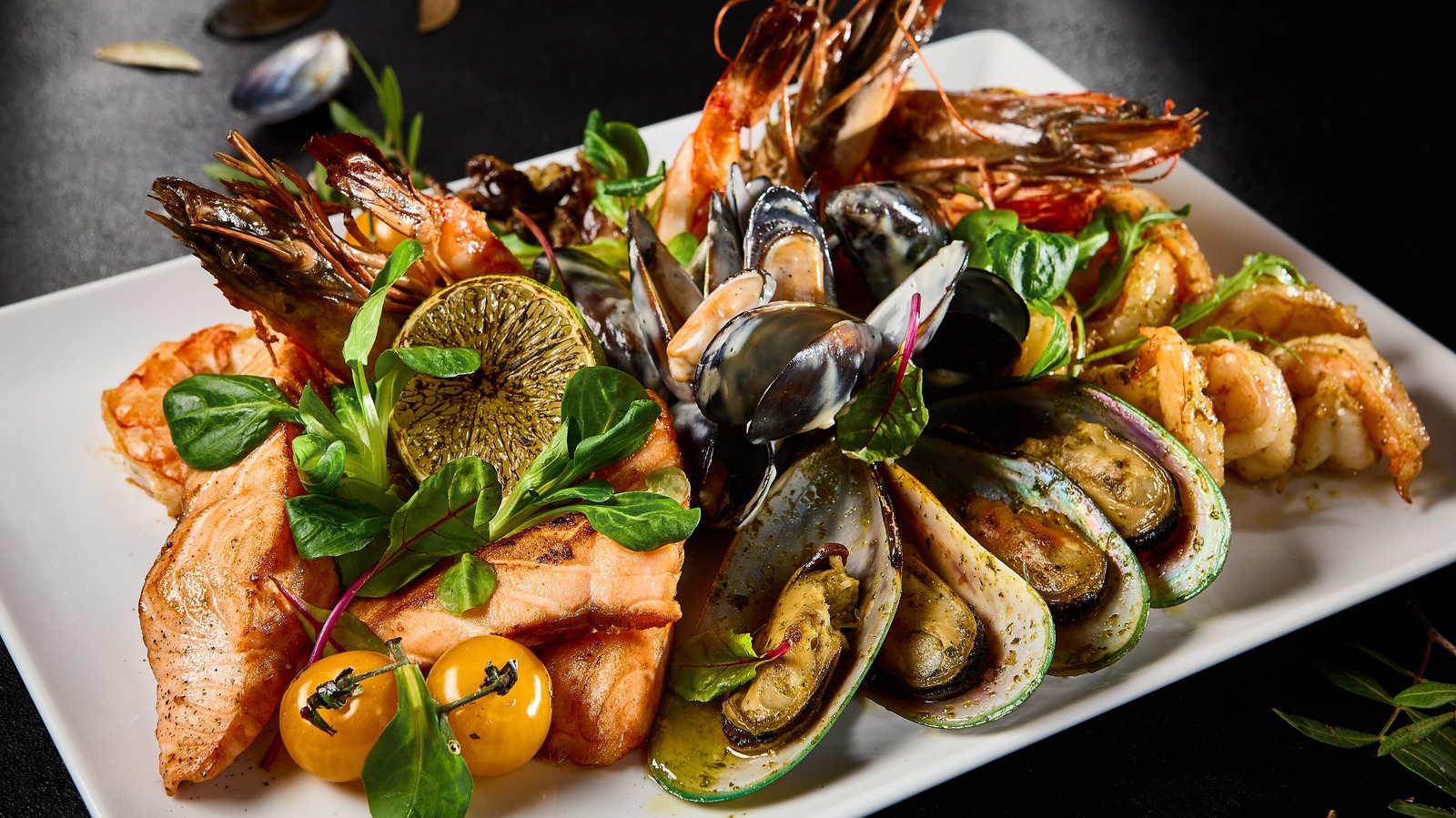Seafood is enjoyed all over the world. While countries and regions with long coastlines generally make the most of their abundant saltwater fish and shellfish, landlocked areas enjoy freshwater fish from lakes and streams as well as dishes using seafood that’s been preserved by smoking or curing.
Wherever you live, there are classic seafood dishes from around the world that you should try at least once in your life. Some are easy to make at home, others are best enjoyed in location or in a restaurant specializing in a particular cuisine.
So step outside your grilled salmon and fish and chips comfort zone and try this selection of classic seafood dishes. Some are raw, some cured, and some cooked. From bivalves (like clams), to crustaceans (such as prawns and crabs), and many different species of fish, these are all classic seafood dishes you really have to try at least once.
New England clam chowder
Clam chowder originated on the northeastern coast of North America in the 18th century around what is now New England, with its cold Atlantic waters and long shoreline perfect for gathering clams. It’s likely the name chowder comes from chaudière, the cast-iron cooking cauldrons used by early French settlers in Canada. It’s also likely they made the earliest forms of clam chowder which then spread south into New England, where the clams (such as quahogs) were mostly too large and tough to be eaten whole. It didn’t take the thrifty settlers long to realize they were delicious chopped up with potato, onion, and a little salt pork, and enriched with milk, to create a hearty, filling dish halfway between a soup and a stew, and clam chowder is still an easy dish to make at home.
As with many traditional dishes, chowder has regional variations. With the increased popularity of the tomato in the mid-1800s, and the influence of New York’s large Italian population, a tomato-based chowder (that came to be called Manhattan clam chowder) became the norm in New York. New Englanders swear their milk-based version is the only authentic one and, in 1939, a bill was introduced in Maine to make the use of tomato in clam chowder illegal. Chowder can be made using any mollusks — including oysters, mussels, abalone, and conch shell — but New England clam chowder is a classic seafood dish you have to try at least once.
Moules marinières
The French dish of moules marinières (literally mussels prepared mariner-style) is perhaps the most widely known mussel dish. It’s also one of the easiest ways to cook mussels at home by simply steaming them open in a pan with some white wine, garlic, parsley, and butter. In Belgium, where beer is sometimes used instead of wine, chips (frites) and mayonnaise are popular accompaniments, and the dish is often called moules frites.
If you’re making moules marinières at home, the most important thing is to remove the shells from the pan as they open, so that they don’t overcook. Once all the shells have opened, toss them back through the sauce to ensure they’re warm and well combined.
Whether at home or in a restaurant, the best way to eat moules marinières is to abandon knives and forks and use the shell from the first mussel as an implement for scooping the others out of their shells. Any other bivalves (clams) can be prepared in the same way, but then they aren’t “moules,” which is French for mussels.
Oysters Rockefeller
Antoine’s Restaurant, in New Orleans’ French Quarter, is credited with creating oysters Rockefeller in the late 1800s as an alternative to escargots à la Bourguignonne when snails were in short supply. Oysters Rockefeller was allegedly named after oil millionaire John D. Rockefeller because the sauce was so rich.
While some people aren’t wild about eating raw oysters, most can face them cooked, especially covered in a rich herb sauce topped with crunchy breadcrumbs. Even if you’re dubious about eating oysters, this is a classic seafood dish you need to try that needs to make a comeback. While Antonine’s original recipe is still secret, tasty oysters Rockefeller are surprisingly easy to make at home. Any combination of green herbs (such as parsley, tarragon, and chervil) works well, and many recipes include spinach or watercress. A splash of anise-flavored liquor, like Pernod or another pastis, adds great flavor, too.
Abalone steaks
Pan-fried abalone steaks are especially popular on the Pacific coast of the USA where, in the early 20th century, German immigrant Ernest “Pop” Doelter created them in his Monterey Bay restaurant, Café Ernest. Abalone is large sea snail that’s generally hand harvested and popular in some Asian cuisines, especially Japanese. It was experienced Japanese divers that supplied abalone to Pop’s restaurant, but it was Pop who — probably inspired by German schnitzel — figured out how to make these rather tough creatures appealing to local customers.
Pop pounded the large firm foot of the abalone into a thin tender steak, coated it in egg and breadcrumbs and fried it, just like a schnitzel. By the 1920s he’d moved his restaurant to Monterey’s Old Fishermen’s Wharf and was also shipping his abalone steaks throughout California. If you’re making your own fried abalone steaks, the secret is to pound them just enough to tenderize them without making them mushy.
Of course it’s not just Japanese that appreciate abalone, it’s been part of the diet of native people for millennia, from the Rumsen of the Monterey region to the Māori of New Zealand, where abalone is called pāua. The word “abalone” is derived from its Rumsen name: aulun.
Maine and Connecticut lobster rolls
While other states lay claim to lobster rolls, especially Connecticut where they likely originated, today they’re most strongly associated with Maine. Maine’s lobster fishing industry dates to at least the 17th century and it now supplies more lobsters than any other American state. A traditional Maine lobster roll is a cold sandwich in a soft hot dog-style bun that’s toasted, spread with mayonnaise, and filled with plenty of freshly boiled cold lobster meat.
While a Maine lobster roll is definitely a classic seafood dish you need to try — ideally in Maine — you should also try its Connecticut counterpart for comparison. A classic lobster roll in Connecticut is served in a similar toasted hot dog bun, but the lobster meat has been warmed in melted butter, more of which is often served on the side. Which is best is a question of personal taste and no doubt state loyalty. Lobster rolls are an easy indulgence to enjoy at home, with endless variations to suit every taste from herb mayo classics to fancy caviar-topped creations.
Singapore chili crab
When most people think of eating in Singapore, they think of chili crab. This classic seafood dish is found all over the island, from fine dining restaurants to hawker stalls, and is also the most recognizable Singaporean dish abroad. Singapore chili crab is said to have been created in the 1950s by a cook who initially sold it from a cart along the waterfront. As her business grew, she and her husband opened Palm Beach restaurant, the first Singaporean restaurant selling chili crab.
Authentic chili crab stays true to its hawker roots, using bottled chili sauce and tomato ketchup. Much more than just spicy crab, traditional Singapore chili crab is memorable for its rich sauce thickened with ribbons of beaten egg that are drizzled in at the last moment before serving.
There’s no delicate way to eat chili crab, you need to dive in with your hands, using crackers and picks to extract the tasty meat in the claws. The sauce is as important as the crab and aficionados mop up every last drop, usually with soft white bread such as baguettes or steamed mantou buns rather than rice. Whether you’re cooking chili crab yourself or eating it in Singapore, ensure your crab is as fresh as possible, ideally sourced straight from the tank like the best seafood restaurants in Singapore do.
Tom Yum Goong
Hot and sour soup is very popular in Thailand, where it’s called tom yum (also spelled dtom yum). In Thai, “tom” means to boil and “yum” means to toss together, and tom yum can be as basic or as complex as the cook wishes. It can be vegetarian or include meat or seafood, and the best-known tom yum outside Thailand is tom yum goong, made with prawns. Tom yum is always hot and sour and based on an aromatic tom yum paste flavored with lemongrass, makrut (kaffir) lime leaves, and galangal — a relative of ginger with a spicy, piney, almost citrus flavor.
Thai meals don’t follow the western pattern of serving one dish at a time, instead all savory dishes, including soups, are placed on the table together with rice and a range of condiments, so each diner can season their food to suit their taste. Soup isn’t a first course, rather it’s sipped throughout the meal to refresh the palate between other dishes. Before sipping your tom yum, add some extra chili for heat, lime juice for sourness, or fish sauce for saltiness according to your preference.
Gravlax
You’ve likely had smoked salmon, but have you tried its classic Nordic alternative: gravlax? The name comes from “gravad-lax” a Swedish term that literally means “buried salmon,” a reference to the ancient Scandinavian practice of wrapping salted fish in bark and burying it in the cold soil to preserve it through winter.
Gravlax is one of the easiest classic seafood dishes to create at home and makes for an impressive starter or buffet centerpiece. Traditionally, gravlax is made with a whole side of salmon with the skin still on, though you can use a smaller portion if you wish. The flesh-side of the salmon is coated with a mixture of salt, white pepper, sugar, and usually chopped dill; modern recipes also often add a splash of a spirit, such as gin.
Wrap the salmon tightly in plastic wrap, place it on a tray with a lip to catch any liquid, weigh it down with some cans or a heavy pot, and refrigerate it for two to three days, turning it twice a day. That’s it — after two days, it’s a bit like sashimi, and after three days it’s more like smoked salmon without the smokiness. Wipe off the cure, slice it finely and use it anywhere you’d use smoked salmon.
Ceviche
Ceviche, a classic Peruvian dish of lime-marinated fish, is a great first step for people who want to try raw seafood but aren’t quite ready to go the full sashimi. The acid in the lime juice denatures the protein in the fish in a similar way to heat, turning the flesh white and softening it so that it looks and feels cooked.
As the seafood isn’t actually being cooked though, it’s important to use the freshest possible fish, sold as “sashimi-grade.” Buying a sashimi-grade block of fish also means it’s already boned and trimmed of all skin and sinew, ready for you to dice and marinate.
The marinated fish is typically mixed with a few other chopped ingredients, traditionally onion, chili, and cilantro. It makes a delicious starter served with plain corn chips and also a great taco filling. The marinade, called “leche de tigre” (tiger’s milk), is often served as a separate dish. Bajan conch salad employs a similar technique to “cook” the shellfish, and related dishes popular throughout the Pacific Islands include Fijian kokoda which includes coconut milk.
Sole à la meunière
Meunière is classic French sauce that’s popular with flat fish such as sole or flounder. À la meunière literally means “in the style of the miller’s wife” and anything cooked this way is dredged in flour before being fried because the miller’s wife always had plenty of flour on hand. The flour adds a crisp coating and a lovely golden color. It helps stop the fish from sticking to the pan, too.
Try sole à la meunière in a classic French bistro at least once. As it’s made with the most basic ingredients — flour, butter, a little parsley, and lemon juice — classic sole à la meunière is also an easy dish to serve at home. The most important thing is getting the butter really dark without burning it. It requires a little practice and courage to push it past the point where you think it’s done, then quickly stop the cooking with a squeeze of lemon juice; but it’s a skill worth practicing and mastering. If you don’t cook it quite long enough, you’ll have beurre noisette (literally “hazelnut butter”) rather than beurre noir (literally “black butter”), which is still delicious. Some cooks toss a few capers into the butter at the last minute for added zing.
Cajun blackened catfish
Louisiana chef Paul Prudhomme is credited with developing the “blackened” cooking method and the spice mixture used for one of the best-known Cajun dishes: Cajun blackened catfish. Catfish are traditionally used in this dish because they’re abundant in the bayous of Louisiana, but any mild-tasting, white-fleshed fish works well.
You should try this classic seafood dish at least once in Louisiana, though it’s easy to cook Cajun blackened fish at home, too. Thin fillets are best as they cook before the spice mixture burns, you want it blackened a little but not charred to the point where it’s bitter. Cajun blackened fish is spicy. If you want a milder flavor, hold back on the cayenne or pepper in the spice mixture rather than using less of the mixture on the fish as you need a good coating to get the blackened effect.
If you’re cooking indoors, ensure the exhaust fan is on high or the window is open, otherwise the smoke and chili will set you coughing. Serve your Cajun blackened fish with steamed rice or bread rolls to soak up all the spicy butter, and a crisp coleslaw to cool the heat.
Steamed Chinese-style fish with ginger and scallions
Try this classic seafood dish next time you’re eating in a Chinese restaurant with a group, especially one with live seafood tanks. Live fish is best as it needs to be super fresh to shine with the delicate flavors. The fish is simply steamed with soy sauce and slivers of ginger and scallion, then flashed with some very hot peanut oil to add a sizzling finish and complete the sauce.
Once you’ve tasted it, you’ll want to make it at home, too. While whole fish makes a striking centerpiece and is easy to prepare this way, you can also steam fish fillets with ginger and scallions. When steaming at home, avoid steam burns by removing the steamer basket from the pan or wok before lifting the lid. Take care also with the hot oil as it will spit and sizzle.
Salade Niçoise
Salade Niçoise is named for the southern French port city of Nice in Provence, and it’s one of the most hotly debated seafood recipes around. It’s definitely a dish you must try when holidaying in southern France or when you see it on the menu of a good French bistro.
Today salade Niçoise is considered a tuna salad, and fancier versions replace the more typical canned tuna with seared fresh tuna. It seems however that the original salad didn’t contain any seafood at all, apart from possibly anchovies. It started out as a simple cold salad of typical Provençal vegetables such as tomato, artichokes, bell peppers and olives.
Over time more ingredients were added and today salade Niçoise is a great one dish meal to have in your repertoire, whether you use fresh or canned tuna. Boiled green beans and potatoes are now typical, though apparently not original. Firm waxy potatoes (like kipfler or pink fir) are best as they hold together when tossed through the salad. Hard-boiled eggs, onion and a mustardy red wine vinegar dressing are usually included, while salad leaves are optional.
Bouillabaisse
Seafood soups are traditional all over the Mediterranean, originally made by fishermen cooking whatever they couldn’t sell from the day’s catch, often right on the beach in a large cauldron over an open fire. Bouillabaisse, from around the French port of Marseille in south eastern France, is the best-known of these fishermen’s soups.
In its classic form, bouillabaisse is a dish best enjoyed in France, or at least in an authentic French bistro, as the more varieties of fish the greater the flavor so it’s hard to make in a small quantity. Marseille authorities say that a traditional bouillabaisse requires at least four different species from a specific range of fish and shellfish. Scorpionfish (often called rockfish) are the most common, perhaps because they’re small, bony, and ugly so didn’t traditionally sell well. Saffron and fennel are also essential and dried orange peel appears in many traditional recipes.
A traditional bouillabaisse is made in two parts: a rich base of vegetables and small inexpensive whole fish boiled together then pureed, and pieces of more premium fish and shellfish poached and then served with the soupy base. The traditional accompaniment to bouillabaisse, rouille, is a rich red capsicum, chili, and garlic emulsion that’s easy to make at home to spice up any soup.




